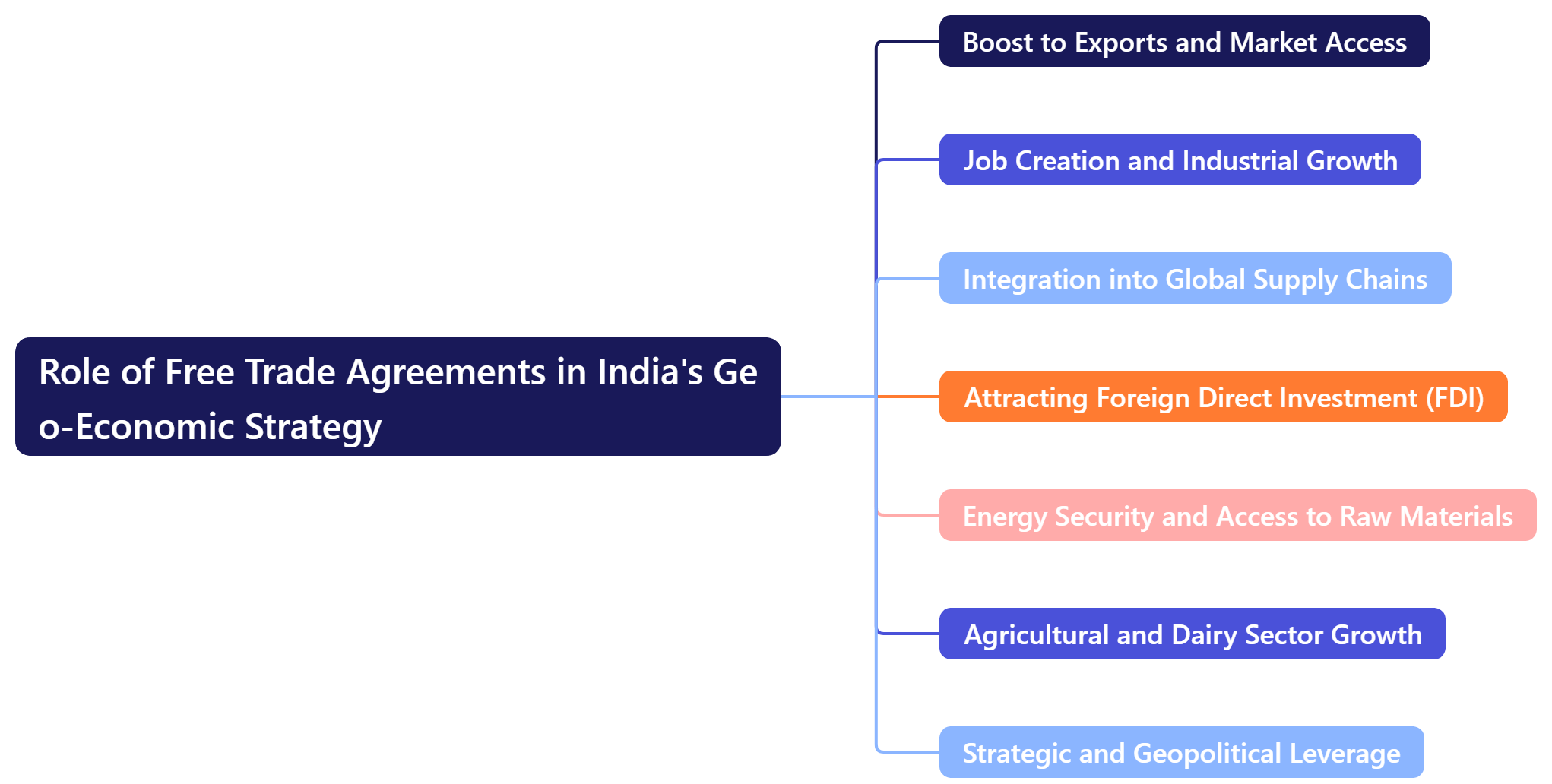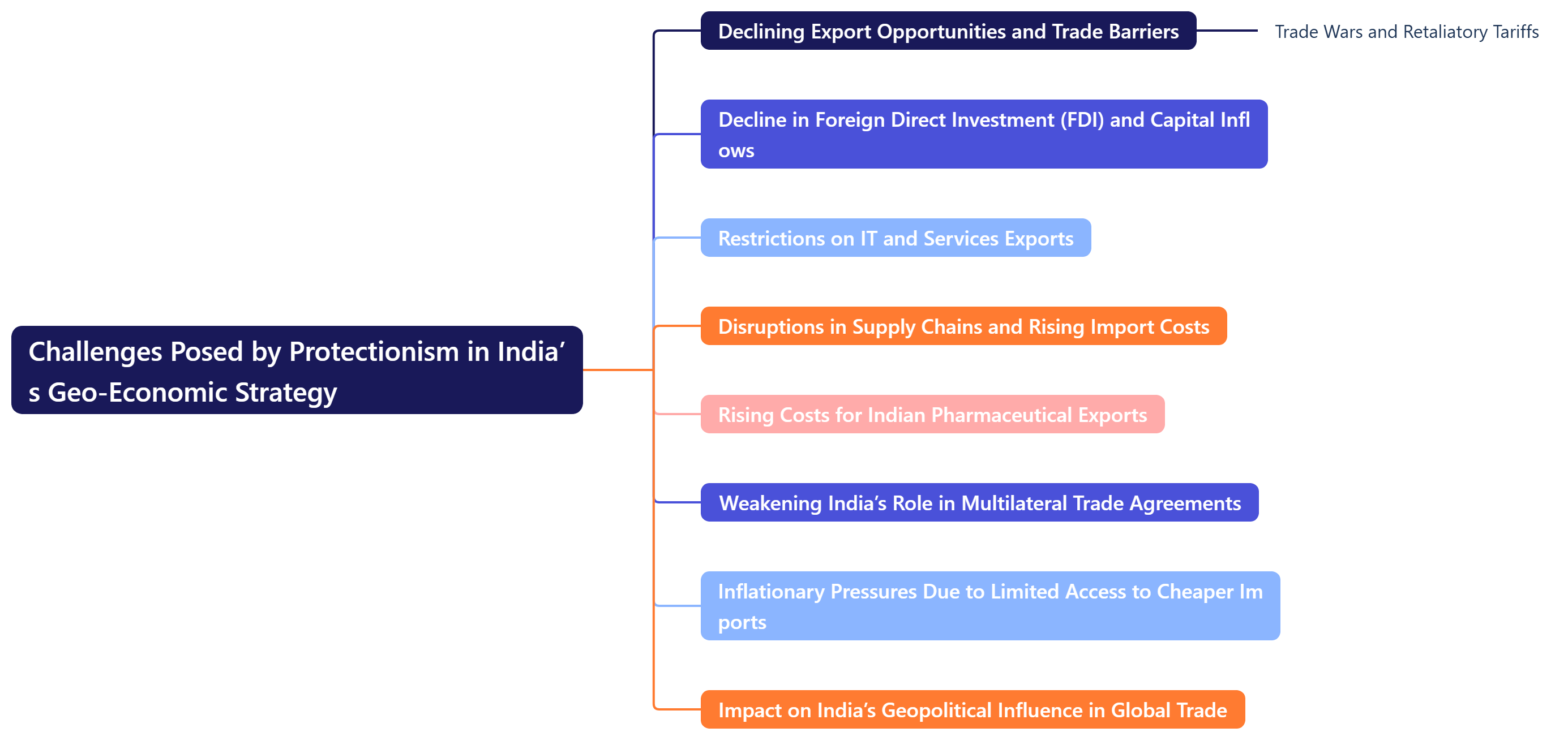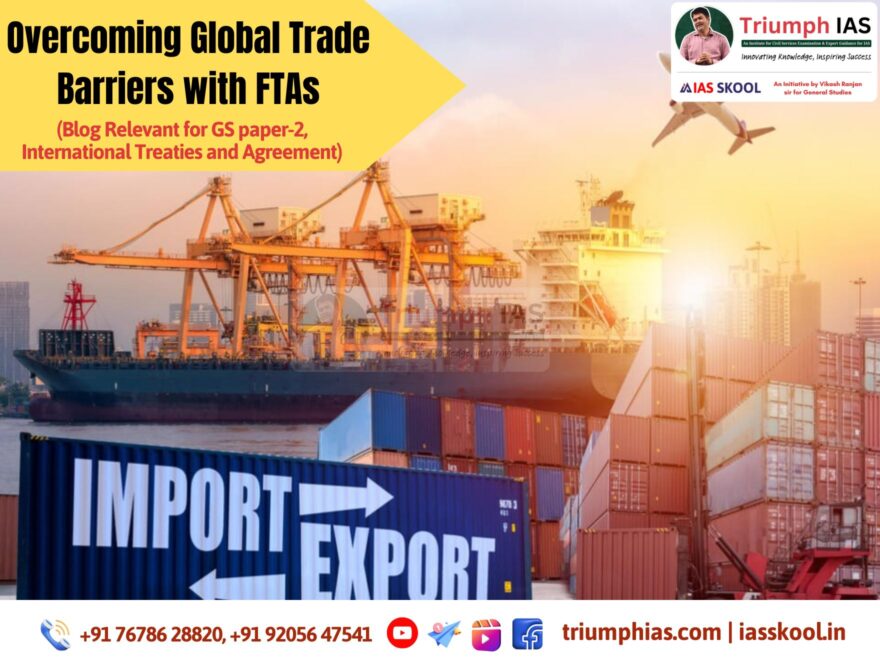|
Despite broad academic support for free trade, protectionist economic policies are gaining momentum globally, especially in developed nations like the United States.
The recent U.S. election has revived the “America First” agenda, signaling a shift toward mercantilist policies, higher tariffs, and a preference for bilateral agreements over established multilateral frameworks like the World Trade Organization (WTO).
As global trade dynamics evolve, India must strategically adapt by forging strong partnerships and employing effective negotiation tactics to safeguard its interests in bilateral and multilateral trade while ensuring a stable geo-economic outlook.
Role of Free Trade Agreements in India’s Geo-Economic Strategy

Boost to Exports and Market Access
Free Trade Agreements (FTAs) provide preferential market access for Indian exporters by reducing tariffs and non-tariff barriers, enhancing the global competitiveness of Indian goods.
- This is particularly beneficial for industries such as textiles, pharmaceuticals, and electronics, where India holds a comparative advantage.
- As global trade becomes more fragmented, FTAs help Indian businesses integrate into global supply chains, fostering export-led growth.
- Example: Under the Comprehensive Economic Partnership Agreement (CEPA) with the UAE, India’s exports to the UAE rose to $31.3 billion in 2022-23, reflecting a 12% increase from $28 billion in 2021-22.
Job Creation and Industrial Growth
By expanding market opportunities, FTAs drive manufacturing expansion, creating jobs in labor-intensive sectors like textiles, leather, and agriculture.
- Duty-free imports under FTAs lower input costs, allowing MSMEs to scale up and compete globally.
- Strengthening domestic industries through FTAs aligns with India’s Production-Linked Incentive (PLI) schemes, attracting foreign investment.
- Example: India’s textile industry, previously facing setbacks, is now poised for growth, with exports projected to reach $65 billion by FY26, largely due to rising trade agreements.
Integration into Global Supply Chains
FTAs enable deeper participation in Global Value Chains (GVCs) by boosting trade in intermediate goods and reducing over-dependence on specific sources like China.
- This is essential as India seeks to establish itself as a global manufacturing hub under initiatives like ‘Make in India’ and ‘Atma Nirbhar Bharat’.
- Example: India’s ongoing FTA negotiations with the UK, EU, and Canada aim to strengthen key sectors like automobiles, electronics, and IT services, further integrating India into global supply chains.
Attracting Foreign Direct Investment (FDI)
FTAs enhance investor confidence by ensuring a stable trade environment, leading to increased FDI inflows, particularly in manufacturing and services.
- Tariff concessions under FTAs encourage partner countries to invest in India’s large domestic market.
- Example: The India-Korea Comprehensive Economic Partnership Agreement (CEPA) has facilitated easier FDI regulations for both nations.
- Additionally, in October 2021, the UAE pledged $75 billion in sovereign funds to support India’s clean energy sector.
Energy Security and Access to Raw Materials
FTAs help secure duty-free or concessional imports of critical raw materials such as crude oil, LNG, and rare earth minerals, strengthening supply chain resilience.
- This is crucial as India transitions towards clean energy and seeks to reduce dependency on a few supplier nations.
- Example: India is actively negotiating agreements for rare earth minerals with Australia and participating in the Minerals Security Partnership (MSP) to diversify resource access.
Agricultural and Dairy Sector Growth
FTAs create new market opportunities for Indian agricultural exports, including rice, spices, and marine products, benefiting farmers and rural economies.
- However, cautious negotiations are essential to protect sensitive sectors, such as dairy, from excessive foreign competition.
- Example: The India-Japan CEPA eliminates duties on nearly 90% of traded products, including several agricultural commodities.
Strategic and Geopolitical Leverage
FTAs serve as key economic diplomacy tools, strengthening India’s global influence and reducing reliance on China-centric supply chains.
- Expanding trade partnerships enables India to counterbalance China’s dominance in regional trade and promote its Indo-Pacific strategy.
- Example: In 2024, India signed a Trade and Economic Partnership Agreement (TEPA) with EFTA nations (Switzerland, Norway, Iceland, Liechtenstein), reinforcing economic resilience.
Challenges Posed by Protectionism in India’s Geo-Economic Strategy

Declining Export Opportunities and Trade Barriers
As major economies implement higher tariffs and non-tariff barriers to safeguard their domestic industries, Indian exports face reduced market access and competitiveness.
- This particularly affects labor-intensive industries such as textiles, gems & jewelry, and agriculture, limiting India’s ability to expand its global trade footprint.
- Protectionist policies like localization mandates and increased tariffs in the U.S. and EU hinder Indian manufacturers, slowing export growth.
- Example: India strongly opposes the EU’s proposal to impose high tariffs (20%-35%) on high-carbon goods like steel, aluminum, and cement starting January 2026. However, the EU has not indicated any exemptions, citing its clean energy goals.
Trade Wars and Retaliatory Tariffs
Rising trade conflicts, such as the U.S.-China trade war, disrupt global trade flows, indirectly impacting India’s exports and investments.
- Retaliatory tariffs imposed by key trading partners increase the cost of Indian goods, reducing demand in markets like the U.S. and EU.
- Protectionist disruptions may widen India’s trade deficit, undermining balanced trade agreements.
- Example: India’s exports to China declined by 14.85%, from $13.48 billion (April 2023 – January 2024) to $11.48 billion (April 2024 – January 2025) due to extended protectionist measures.
Decline in Foreign Direct Investment (FDI) and Capital Inflows
Stricter investment restrictions in developed economies, particularly on foreign acquisitions, make it challenging for Indian companies to expand internationally and attract capital.
- The U.S. and EU have implemented stricter foreign investment screening mechanisms, making it harder for Indian firms to acquire technology and businesses abroad.
- Example: Global FDI declined by 2% to $1.3 trillion in 2023, driven by an economic slowdown and geopolitical tensions, as per the World Investment Report 2024.
- India’s total FDI inflows fell by 16% to $70.9 billion (₹6 lakh crore) in FY24.
Restrictions on IT and Services Exports
Developed nations are tightening work visa policies and enforcing data localization laws, impacting India’s IT and outsourcing industry.
- Stricter H-1B visa norms and growing anti-outsourcing sentiment in the U.S. and Europe make it difficult for Indian tech professionals to access key markets.
- Example: Between October 2022 and September 2023, Indian skilled workers received only 72.3% of all H-1B visas issued, affecting employment and foreign exchange earnings.
Disruptions in Supply Chains and Rising Import Costs
Global protectionist policies disrupt supply chains, making it difficult for India to source critical raw materials such as semiconductors, rare earth metals, and energy resources.
- Import restrictions in nations like the U.S. and China increase costs for Indian manufacturers, impacting electronics, defense, and renewable energy sectors.
- Example: India imports 85% of its crude oil, and following the Russia-Ukraine conflict, rising oil prices significantly increased India’s import bill.
- Additionally, 65-70% of electronic components in India are sourced from China, making supply chain disruptions a serious concern.
Rising Costs for Indian Pharmaceutical Exports
Stricter intellectual property (IP) laws and tighter regulatory standards in developed nations have increased compliance costs for Indian pharmaceutical exports.
- Countries like the U.S. and EU have heightened scrutiny on Indian pharmaceutical firms, delaying approvals and restricting market access.
- Example: The World Health Organization (WHO) linked Indian-manufactured cough syrups to acute kidney failure and the deaths of 66 children in The Gambia, raising concerns about India’s credibility in the global pharma market.
Weakening India’s Role in Multilateral Trade Agreements
With rising protectionism, developed economies are shifting focus toward regional trade blocs, such as the Comprehensive and Progressive Agreement for Trans-Pacific Partnership (CPTPP), marginalizing India in global trade negotiations.
- The absence of preferential trade agreements puts India at a competitive disadvantage, as its exports face higher tariffs and non-tariff barriers compared to CPTPP member nations.
- Example: India’s exclusion from the Regional Comprehensive Economic Partnership (RCEP) has already resulted in trade losses, and further protectionist trends could economically isolate India.
Inflationary Pressures Due to Limited Access to Cheaper Imports
Protectionist measures drive up global prices for essential commodities like food, fuel, and industrial inputs, intensifying inflationary pressures in India.
- Export restrictions by key commodity-exporting countries elevate costs for Indian consumers.
- Example: Indonesia’s palm oil export ban in 2023 led to a surge in edible oil prices in India.
- Similarly, Russia’s wheat export restrictions have contributed to rising food inflation.
Impact on India’s Geopolitical Influence in Global Trade
The shift toward economic nationalism poses challenges for India’s leadership role in global trade governance.
- The increasing use of unilateral protectionist measures by developed economies diminishes the relevance of WTO-led negotiations, limiting India’s ability to influence fair trade policies.
- Example: Despite India’s G20 Presidency in 2023, where it advocated for WTO reforms, major economies like the U.S. and EU continued to impose unilateral tariffs, undermining India’s push for multilateralism.
Safeguarding India’s Economic Interests in a Shifting Geoeconomic Landscape
Accelerating Free Trade Agreements (FTAs) for Market Diversification
India must fast-track the negotiation and implementation of FTAs with key economies to secure preferential market access and minimize tariff barriers.
- Strengthening trade partnerships with regions such as the EU, UK, Canada, and the GCC will help mitigate the impact of rising protectionism in developed economies.
- A balanced strategy is essential—protecting domestic industries while ensuring global competitiveness.
- Emphasizing services trade, digital economy provisions, and investment protection in FTAs will enhance India’s long-term economic resilience.
Boosting Domestic Manufacturing and Integration into Global Value Chains
India must deepen its involvement in global value chains (GVCs) by expanding domestic manufacturing capabilities and reducing import dependence.
- Strengthening the Production-Linked Incentive (PLI) schemes and streamlining logistics and supply chain processes will enhance India’s global industrial competitiveness.
- Prioritizing high-value industries such as semiconductors, electronics, and green technology will minimize vulnerabilities in strategic sectors.
- Aligning trade policies with export-driven manufacturing will enable India to capture a larger share of global trade.
Enhancing Trade Diplomacy and Strategic Economic Alliances
India must adopt a proactive trade diplomacy approach to counter rising protectionism and negotiate favorable trade agreements with key global partners.
- Strengthening participation in international forums like the G20, WTO, and BRICS will help shape global trade policies aligned with India’s economic priorities.
- Expanding economic collaboration with Africa and Latin America will open alternative markets, reducing reliance on traditional trade partners.
- Leveraging diplomatic channels to resolve trade disputes and advocating against unfair trade practices will help protect India’s exporters and economic interests.
As global economies shift towards protectionist policies, India must strategically utilize Free Trade Agreements (FTAs) to expand market access, integrate into global value chains, and attract foreign investments. |




One comment